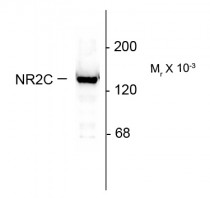ARG52371
anti-NMDAR2C antibody
anti-NMDAR2C antibody for Immunoprecipitation,Western blot and Human,Mouse,Rat
Neuroscience antibody
Overview
| Product Description | Rabbit Polyclonal antibody recognizes NMDAR2C |
|---|---|
| Tested Reactivity | Hu, Ms, Rat |
| Tested Application | IP, WB |
| Host | Rabbit |
| Clonality | Polyclonal |
| Isotype | IgG |
| Target Name | NMDAR2C |
| Antigen Species | Rat |
| Immunogen | Fusion protein from the N-terminal region of the NR2C subunit |
| Conjugation | Un-conjugated |
| Alternate Names | Glutamate receptor ionotropic, NMDA 2C; NR2C; Glutamate [NMDA] receptor subunit epsilon-3; GluN2C; N-methyl D-aspartate receptor subtype 2C; NMDAR2C |
Application Instructions
| Application Suggestion |
|
||||||
|---|---|---|---|---|---|---|---|
| Application Note | Specific for the ~140k NR2C subunit of the NMDA receptor. Also labels the ~180k NR2A and the ~180k NR2B subunits of the NMDA receptor. Immunolabeling is blocked by preadsorption of antibody with the immunogen that was used to geneRate the antibody. * The dilutions indicate recommended starting dilutions and the optimal dilutions or concentrations should be determined by the scientist. |
Properties
| Form | Powder |
|---|---|
| Purification | Affinity Purified |
| Buffer | Lyophilized |
| Storage Instruction | For continuous use, store undiluted antibody at 2-8°C for up to a week. For long-term storage, aliquot and store at -20°C or below. Storage in frost free freezers is not recommended. Avoid repeated freeze/thaw cycles. Suggest spin the vial prior to opening. The antibody solution should be gently mixed before use. |
| Note | For laboratory research only, not for drug, diagnostic or other use. |
Bioinformation
| Database Links | |
|---|---|
| Gene Symbol | GRIN2C |
| Gene Full Name | glutamate receptor, ionotropic, N-methyl D-aspartate 2C |
| Background | The ion channels activated by glutamate that are sensitive to N-methyl-Daspartate (NMDA) are designated NMDA receptors (NMDAR). The NMDAR plays an essential role in memory, neuronal development and it has also been implicated in several disorders of the central nervous system including Alzheimer’s, epilepsy and ischemic neuronal cell death (Grosshans et al., 2002; Wenthold et al., 2003; Carroll and Zukin, 2002). The NMDA receptor is also one of the principal molecular targets for alcohol in the CNS (Lovinger et al., 1989; Alvestad et al., 2003; Snell et al., 1996). The NMDAR is also potentiated by protein phosphorylation (Lu et al., 1999). The rat NMDAR1 (NR1) was the first subunit of the NMDAR to be cloned. The NR1 protein can form NMDA activated channels when expressed in Xenopus oocytes but the currents in such channels are much smaller than those seen in situ. Channels with more physiological characteristics are produced when the NR1 subunit is combined with one or more of the NMDAR2 (NR2 A-D) subunits. The NR2C subunit of the receptor is thought to influence the NMDAR conductance level (Ebralidze et al., 1996). |
| Research Area | Neuroscience antibody |
| Calculated MW | 134 kDa |
Images (1) Click the Picture to Zoom In






